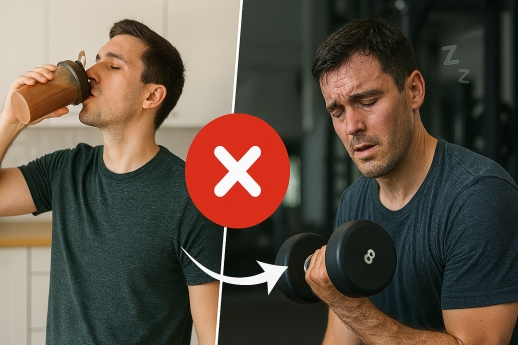Supplements taken wrong: mistakes that cancel their effects

Many athletes use dietary supplements, sometimes wisely. However, there are also common usage mistakes that render even the most effective ones completely useless. Here’s an overview of these errors, with a clear explanation of why they cancel out the expected benefits.
Whey protein before training: a bad idea
Drinking a whey protein shake right before a workout is one of the most common mistakes. When you haven’t eaten for a while, your body needs readily available energy. Of the three macronutrients—carbohydrates, fats, and proteins—protein is the least efficient at providing energy.
To be used as fuel, protein must be converted, which consumes energy. As a result, taking whey just before a workout is probably the worst choice. What you need is a quality source of carbohydrates like a banana, dates, or figs. If you're too hungry, you can add an apple or a handful of nuts to keep you full without feeling heavy.
Creatine cycles: an ineffective strategy
Many athletes still follow 'cycles' of creatine, often taken just before training. However, this supplement has no immediate effect. It’s not a stimulant like caffeine.
To experience its effects, your muscle stores of phosphocreatine need to be saturated. This is achieved by taking around 5 g daily, every day. Stopping intake reduces saturation and cancels out the benefits. Contrary to popular belief, there are no known risks to kidneys or testosterone when creatine is taken correctly.
In other words, taking breaks or forgetting to take it regularly makes creatine ineffective. It must be part of your routine, taken with your main meals.
Omega-3s: beware of oxidation
The main issue with omega-3s isn’t how to take them, but how to store them. Once the bottle is opened, they must be kept in the refrigerator. Otherwise, they oxidize upon contact with oxygen and become not only ineffective but potentially toxic.
Even in capsule form, oxygen eventually seeps in, like air into a balloon or a tire. That’s why manufacturers add vitamin E to formulas: to slow down oxidation. But after a month, the bottle should be discarded.
Buying a bottle of 1,500 capsules is therefore pointless if you can’t use them within a month. It’s better to opt for 60 to 90 capsule formats or buy in bulk but divided into small containers to open gradually over time.
Conclusion
Dietary supplements can be effective, but only if used correctly. Avoid common mistakes: whey at the wrong time, pointless creatine cycles, and poor omega-3 storage. The key is consistency, proper timing, and good management.
Should you take whey protein before working out?
No, whey does not provide quick energy. Before training, it’s better to choose carbs like a banana or dates.
Should creatine be taken in cycles?
No, it should be taken daily at a consistent dose to maintain muscle saturation and keep its effects.
When should creatine be taken for it to be effective?
Timing doesn’t matter. What’s important is daily intake, preferably with a rich meal.
Can omega-3s be stored at room temperature?
No, they must be kept in the refrigerator once opened to prevent oxidation.
Can you use a 1,500 capsule bottle of omega-3s?
No, because oxidation begins once the bottle is opened. Choose bottles of 60 to 90 capsules or split large quantities into smaller containers.
Are all dietary supplements useful?
No, some like tribulus are ineffective. Only well-researched and properly used supplements are truly beneficial.
Is creatine dangerous for the kidneys or testosterone?
No, no serious studies show any risk to kidney or hormonal health when creatine is used correctly.
Should you take omega-3s if they’re oxidized?
No, oxidized omega-3s are not only ineffective but potentially toxic to the body.
Credits

Sources
- https://pubmed.ncbi.nlm.nih.gov/14600563
- https://www.ncbi.nlm.nih.gov/pmc/articles/PMC3407788
- https://www.nutrimuscle.com/blogs/actualites/indice-totox-omega-3
- https://youtu.be/QDmqb1r2M_A?si=drWTkm2JdEgsMWtz